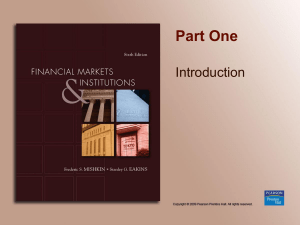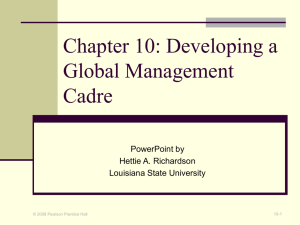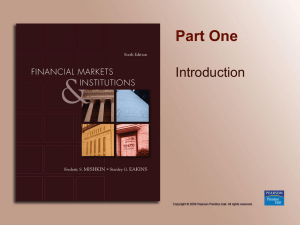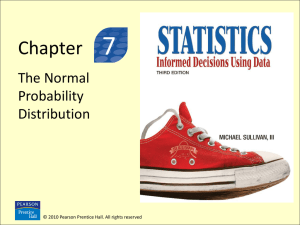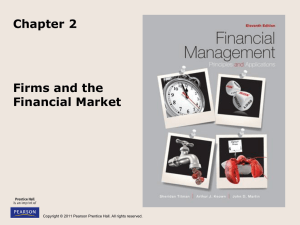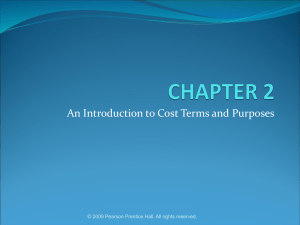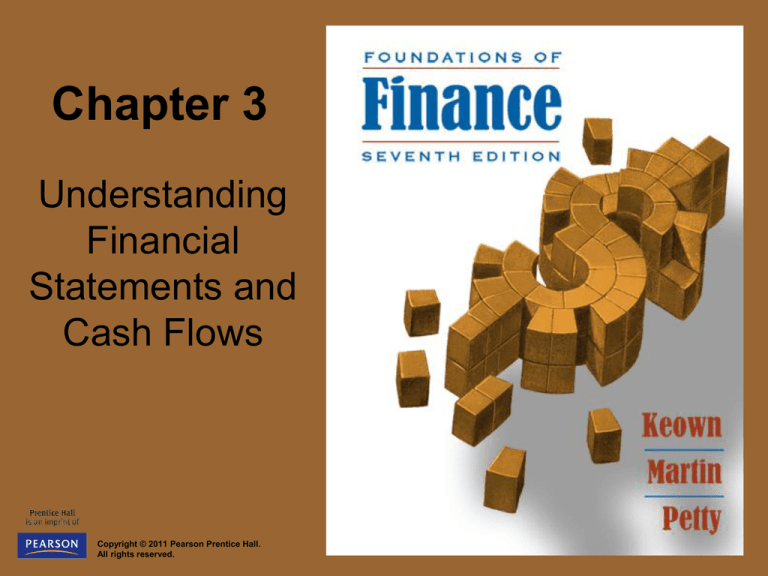
Chapter 3
Understanding
Financial
Statements and
Cash Flows
Copyright © 2011 Pearson Prentice Hall.
All rights reserved.
Learning Objectives
Compute a company’s profits as reflected by its
income statement.
Determine a firm’s financial position at a point in
time based on its balance sheet
Measure a company’s cash flows.
Compute taxable income and income taxes owed.
© 2011 Pearson Prentice Hall. All rights reserved.
3-1
Slide Contents
Principles used in this Chapter
1.
The Income Statement
2.
The Balance Sheet
3.
Measuring Cash Flows
4.
Income Taxes and Finance
© 2011 Pearson Prentice Hall. All rights reserved.
3-2
Principles Applied
in this Chapter
Principle 1:
Cash flow is what matters
Principle 5:
Conflicts of interest cause agency problems
© 2011 Pearson Prentice Hall. All rights reserved.
3
3-3
1. The Income Statement
It is also known as Profit/Loss Statement
It measures the results of firm’s operation over a
specific period.
The bottom line of the income statement shows the
firm’s profit or loss for a period.
Sales – Expenses = Profits
© 2011 Pearson Prentice Hall. All rights reserved.
3-4
Income Statement Terms
Revenue (Sales)
Money derived from selling the company’s product or service
Cost of Goods Sold (COGS)
The cost of producing or acquiring the goods or services to be sold
Operating Expenses
Expenses related to marketing and distributing the product or
service and administering the business
Financing Costs
The interest paid to creditors
Tax Expenses
Amount of taxes owed, based upon taxable income
© 2011 Pearson Prentice Hall. All rights reserved.
3-5
Figure 3-1
© 2011 Pearson Prentice Hall. All rights reserved.
3-6
Figure 3-1 (cont.)
© 2011 Pearson Prentice Hall. All rights reserved.
3-7
Table 3-1
© 2011 Pearson Prentice Hall. All rights reserved.
3-8
Common-size
Income Statement
Common-size income statement restates the
income statement items as a percentage of
sales.
Common-size income statement makes it
easier to compare trends over time and
across firms in the industry.
© 2011 Pearson Prentice Hall. All rights reserved.
3-9
Table 3-2
© 2011 Pearson Prentice Hall. All rights reserved.
3-10
Profit-to-Sales analysis from
Common-size income statement
See Table 3-2
Gross profit margin (or percentage of
sales going towards gross profit) is 23.3%
Operating profit margin (or percentage
of sales going towards operating profit) is
12.5%
Net profit margin (or percentage of sales
going towards net profit) is 7%
© 2011 Pearson Prentice Hall. All rights reserved.
3-11
2. The Balance Sheet
The balance sheet provides a snapshot of a firm’s
financial position at a particular date.
It includes three main items: assets, liabilities and
equity.
Assets (A) are resources owned by the firm
Liabilities (L) and owner’s equity (E) indicate how those
resources are financed
A=L+E
The transactions in balance sheet are recorded
historically at cost price, so the book value of a firm
may be very different from its current market value.
© 2011 Pearson Prentice Hall. All rights reserved.
3-12
Figure 3-3
© 2011 Pearson Prentice Hall. All rights reserved.
3-13
Balance Sheet Terms: Assets
Current assets comprise assets that are relatively
liquid, or expected to be converted into cash within
12 months. Current assets typically include:
Cash
Accounts Receivable (payments due from customers who
buy on credit)
Inventory (raw materials, work in process, and finished
goods held for eventual sale)
Other assets (ex.: Prepaid expenses are items paid for in
advance)
© 2011 Pearson Prentice Hall. All rights reserved.
3-14
Balance Sheet Terms: Assets
Fixed Assets – Include assets that will be used for
more than one year. Fixed assets typically include:
Machinery and equipment
Buildings
Land
Other Assets – Assets that are neither current
assets nor fixed assets. They may include long-term
investments and intangible assets such as patents,
copyrights, and goodwill.
© 2011 Pearson Prentice Hall. All rights reserved.
3-15
Balance Sheet Terms:
Liabilities
Debt (Liabilities)
Money that has been borrowed from a creditor
and must be repaid at some predetermined date.
Debt could be current (must be repaid within
twelve months) or long-term (repayment time
exceeds one year).
© 2011 Pearson Prentice Hall. All rights reserved.
3-16
Balance Sheet Terms:
Liabilities
Current Debt:
Accounts payable (Credit extended by suppliers to a firm
when it purchases inventories)
Accrued expenses (Short term liabilities incurred in the firm’s
operations but not yet paid for)
Short-term notes (Borrowings from a bank or lending
institution due and payable within 12 months)
Long-Term Debt
Borrowings from banks and other sources for more than 1
year
© 2011 Pearson Prentice Hall. All rights reserved.
3-17
Balance Sheet Terms:
Equity
Equity: Shareholder’s investment in the firm in the form of
preferred stock and common stock. Preferred stockholders
enjoy preference with regard to payment of dividend and
seniority at settlement of bankruptcy claims.
Treasury Stock: Stock that have been re-purchased by the
company.
Retained Earnings: Cumulative total of all the net income over
the life of the firm, less common stock dividends that have been
paid out over the years. Note retained earnings are not equal to
hard cash!
© 2011 Pearson Prentice Hall. All rights reserved.
3-18
Balance Sheet: A = L + E
ASSETS (A)
Current Assets
Fixed Assets
Total Assets
LIABILITIES (L)
Current Liabilities
Long-Term Liabilities
Total Liabilities
OWNER’S EQUITY (E)
Preferred Stock
Common Stock
Retained earnings
Total Owner’s Equity
Total liabilities + Equity
© 2011 Pearson Prentice Hall. All rights reserved.
3-19
Table 3-3
© 2011 Pearson Prentice Hall. All rights reserved.
3-20
Net Working Capital
Net Working Capital
= Current assets – current liabilities
Larger the net working capital, better the firm’s ability to
repay its debt
Net working capital can be positive or zero or negative. It is
generally positive.
An increase in net working capital may not always be good
news. For example, if the level of inventory goes up, current
assets will increase and thus net working capital will also
increase. However, increasing inventory level may well be a
sign of inability to sell.
© 2011 Pearson Prentice Hall. All rights reserved.
3-21
Debt Ratio
Debt ratio is the percentage of assets that
are financed by debt.
Debt ratio is an indication of “financial risk.”
Generally, higher the ratio, the more risky
the firm is, as firms have to pay interest on
debt regardless of the earnings or cash
flow situation.
© 2011 Pearson Prentice Hall. All rights reserved.
3-22
3. Measuring Cash Flows
Profits in the financial statements are
calculated on “accrual basis” rather than
“cash basis” (see next slide for accrual
basis accounting).
Thus profits are not equal to cash.
© 2011 Pearson Prentice Hall. All rights reserved.
3-23
Accrual Basis Accounting
Accrual basis is the principle of recording revenues
when earned and expenses when incurred, rather
than when cash is received or paid.
Thus sales revenue recorded in the income statement
includes both cash and credit sales.
Treatment of long-term assets: Asset acquisitions
(that will last more than one year, such as equipment)
are not recorded as an expense but are written off
every year as depreciation expense.
© 2011 Pearson Prentice Hall. All rights reserved.
3-24
Figure 3-6
How to measure a firm’s cash flows
© 2011 Pearson Prentice Hall. All rights reserved.
3-25
Three sources of cash flows
Cash flows from Operations
(ex. Sales revenue, labor expenses)
Cash flows from Investments
(ex. Purchase of new equipment)
Cash flows from Financing
(ex. Borrowing funds, payment of dividends)
© 2011 Pearson Prentice Hall. All rights reserved.
3-26
Three sources of
cash flows (cont.)
If we know the cash flows from
operations, investments and financing,
we can understand the firm’s cash flow
position better, that is, how cash was
generated and how it was used.
© 2011 Pearson Prentice Hall. All rights reserved.
3-27
Income Statement Conversion:
From Accrual to Cash Basis
Two steps:
Add back depreciation (as it is a non-cash
expense) to net income
Subtract any uncollected sales (i.e.
increase in accounts receivable) and cash
payment for inventories (i.e. increase in
inventories less increase in accounts
payables)
© 2011 Pearson Prentice Hall. All rights reserved.
3-28
Figure 3-7
© 2011 Pearson Prentice Hall. All rights reserved.
3-29
Sources and Uses
Sources
Cash inflow – occurs when we “sell” something
Decrease in asset account
Accounts receivable, inventory, and net fixed assets
Increase in liability or equity account
Accounts payable, other current liabilities, and common
stock
Uses
Cash outflow – occurs when we “buy” something
Increase in asset account
Cash and other current assets
Decrease in liability or equity account
Notes payable and long-term debt
3-30
Statement of Cash Flows
Statement that summarizes the sources and
uses of cash
Changes divided into three major categories
Operating Activity – includes net income and
changes in most current accounts
Investment Activity – includes changes in fixed
assets
Financing Activity – includes changes in notes
payable, long-term debt, and equity accounts, as
well as dividends
3-31
Sample Statement of Cash
Flows
Cash, beginning of year
Operating Activity
Financing Activity
Decrease in Notes Payable
Net Income
Decrease in LT Debt
Plus: Depreciation
Decrease in C/S (minus RE)
Decrease in A/R
Decrease in Inventory
Dividends Paid
Net Cash from Financing
Increase in A/P
Increase in Other CL
Net Increase in Cash
Less: Increase in other CA
Net Cash from Operations
Investment Activity
Sale of Fixed Assets
Net Cash from Investments
Cash End of Year
Sample Balance Sheet
2009
2008
2009
2008
Cash
696
58 A/P
307
303
A/R
956
992 N/P
26
119
Inventory
301
361 Other CL
1,662
1,353
Other CA
303
264 Total CL
1,995
1,775
Total CA
2,256
1,675 LT Debt
843
1,091
Net FA
3,138
3,358 C/S
2,556
2,167
Total
Assets
5,394
5,033 Total Liab.
& Equity
5,394
5,033
Numbers in millions of dollars
3-33
Sample Income Statement
Revenues
5,000
Cost of Goods Sold
(2,006)
Expenses
(1,740)
Depreciation
(116)
EBIT
1,138
Interest Expense
(7)
Taxable Income
Taxes
1,131
(442)
Net Income
689
EPS
3.61
Dividends per share
1.08
Numbers in millions of dollars, except EPS & DPS
3-34
Table 3-5
© 2011 Pearson Prentice Hall. All rights reserved.
3-35
In Class Exercise - I
48. Wise's Corner Grocer had the following current account values.
What effect did the change in net working capital have on the
firm's cash flows for 2009?
2008 2009
Cash
87
112
AR
309
321
Inventory
919
868
AP
617
714
A. net use of cash of $37
B. net use of cash of $83
C. net source of cash of $83
D. net source of cash of $111
E. net source of cash of $135
© 2011 Pearson Prentice Hall. All rights reserved.
3-36
In Class Exercise - II
During the year, Kitchen Supply increased its
accounts receivable by $130, decreased its
inventory by $75, and decreased its accounts
payable by $40. How did these three
accounts affect the firm's cash flows for the
year?
A. $245 use of cash
B. $165 use of cash
C. $95 use of cash
D. $95 source of cash
E. $165 source of cash
© 2011 Pearson Prentice Hall. All rights reserved.
3-37
In Class Exercise - III
A firm generated net income of $878. The depreciation
expense was $47 and dividends were paid in the
amount of $25. Accounts payables decreased by
$13, accounts receivables increased by $22,
inventory decreased by $14, and net fixed assets
decreased by $8. There was no interest expense.
What was the net cash flow from operating activity?
A. $876
B. $902
C. $904
D. $922
E. $930
© 2011 Pearson Prentice Hall. All rights reserved.
3-38
4. Income Taxes and Finance
Computing Taxable Income for Corporation
Gross Income
Dollar sales from a product or service less cost of production
or acquisition
Taxable Income
Gross income less tax deductible expenses, plus interest
income received and dividend income received
Tax Deductible Expenses
Include Operating expenses (marketing, depreciation,
administrative expenses) and interest expense
Dividends paid are not deductible
© 2011 Pearson Prentice Hall. All rights reserved.
3-39
Table 3-6
Computing Taxable Income ($000’s)
© 2011 Pearson Prentice Hall. All rights reserved.
3-40
Table 3-7
So if taxable income is 16,000,000, how much is the tax liability?
© 2011 Pearson Prentice Hall. All rights reserved.
3-41
Figure 3-4
© 2011 Pearson Prentice Hall. All rights reserved.
3-42
Table 3-4
© 2011 Pearson Prentice Hall. All rights reserved.
3-43
Key terms
Accounts Payable
Accounts Receivable
Accrual basis accounting
Accrued expenses
Accumulated depreciation
Additional paid-in-capital
Balance sheet
Cash
Common size financial
statements
Common stock
Cost of goods sold
Current assets
© 2011 Pearson Prentice Hall. All rights reserved.
Debt
Debt ratio
Depreciation expenses
EBIT
Earnings before taxes
Earnings per share
Equity
Financing cash flows
Financing cost
Fixed assets
Free cash flows
Gross fixed assets
3-44
Key terms (cont.)
Gross Profit
Gross profit margin
Income statement
Inventories
Long-term debt
Mortgage
Net fixed assets
Net income
Net profit margin
Net working capital
Operating expenses
© 2011 Pearson Prentice Hall. All rights reserved.
Operating income
Operating profit margin
Operating working capital
Par value
Preferred stockholders
Profit margins
Retained earnings
Short-term liabilities
Short-term notes (debt)
Taxable income
Trade credit
Treasury stock
3-45
Now… ThInK
Circuit City went bankrupt in year
2009. It was second in the industry
only after Best Buy.
Now looking back, can you find any
clues from the financial statements
of Circuit city to make predictions
such that Circuit city was in trouble?
© 2011 Pearson Prentice Hall. All rights reserved.
3-46


